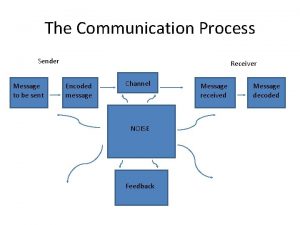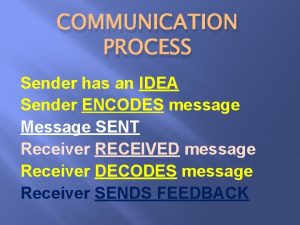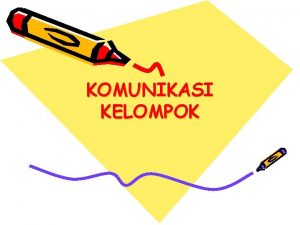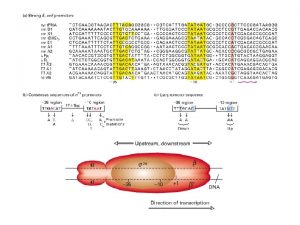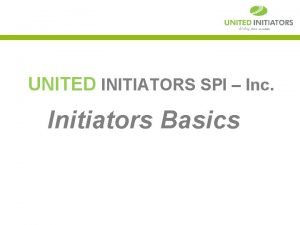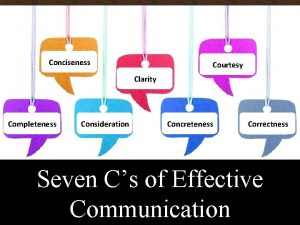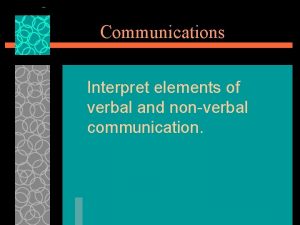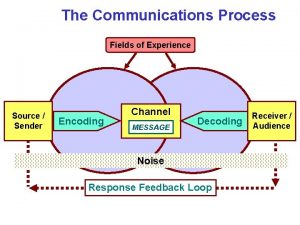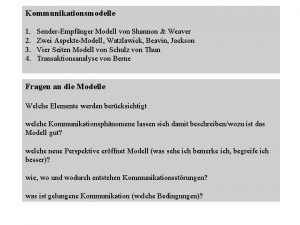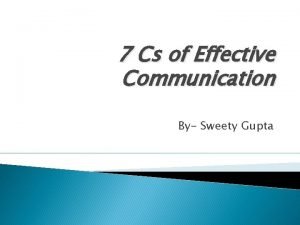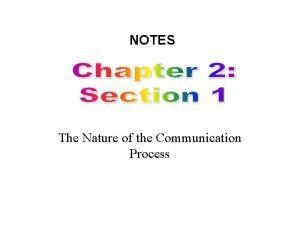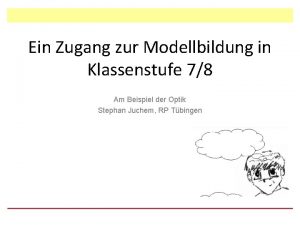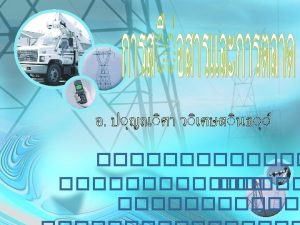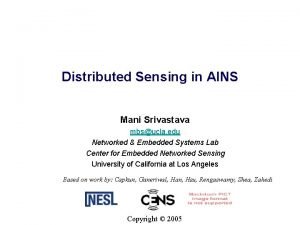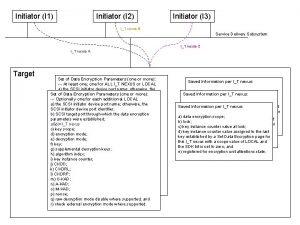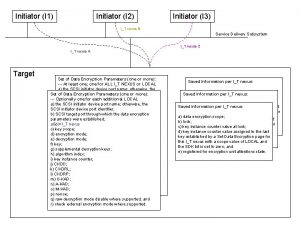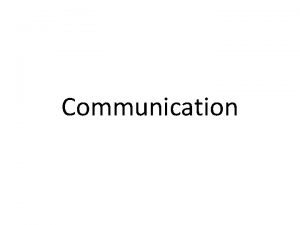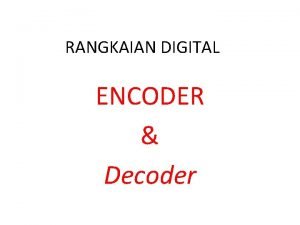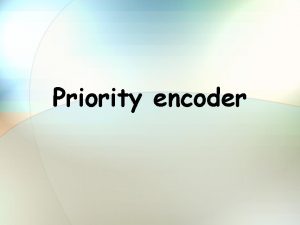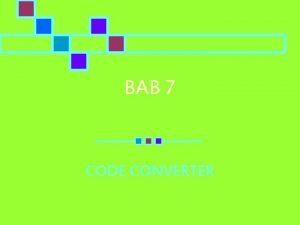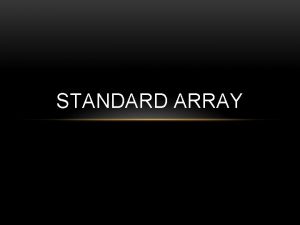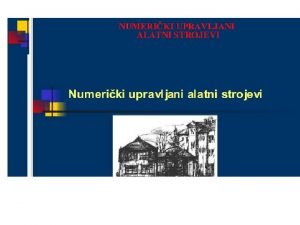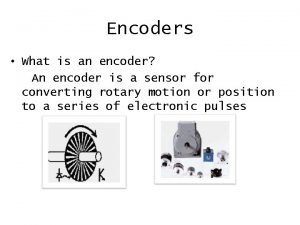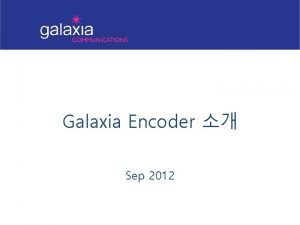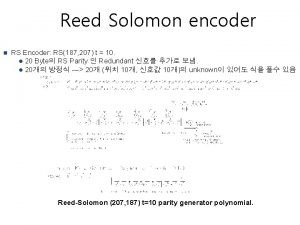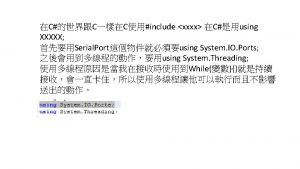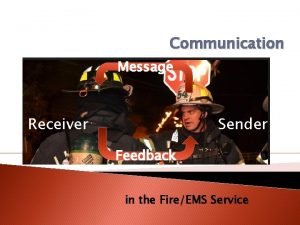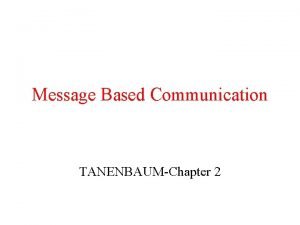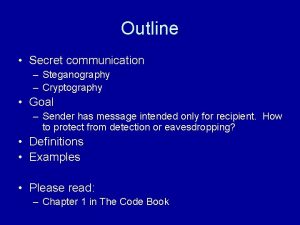Sender Initiator of communication Encoder of message has


























- Slides: 26



Sender • Initiator of communication • Encoder of message (has to decide what to say & how to say it) • Speaker or performer who uses verbal and nonverbal means of communication

The Communication Process 3. _____ 4. _______ 5. __ codi Start h __ ng __ ere __ __ 2. En __ __ 6. _______ __ 9. _______ 7. _ __ __ __ 10 __ __ 1. Sender 8. _______

Encoding • Sender’s selection of a means of expression (what will I say & how will I say it so my audience can understand? ) • Translating ideas into forms of expression • Selecting appropriate symbols and words for the receiver

Levels of Information • Cultural – Race – Sex – National background • Sociological – Level of education – Income – Social class • Individual – Interests, hobbies, social groups, etc.

The Communication Process __ __ 2. En __ __ codi Start h __ __ ng __ ere 4. _______ 5. 3. Message (Verbal/ Nonverbal) 6. _______ __ 9. _______ 7. _ __ __ __ 10 __ __ 1. Sender 8. _______

Message • Information - WHAT is said & HOW it is said. • A systemic translation of a sender’s intention into a code (for example, language or signs) • A verbal or nonverbal expression of a sender’s purpose • The product of a sender’s efforts at communication

Verbal Communication • Sending a message to a receiver through words.

Nonverbal Communication • Messages sent by means other than words – Appearance – Voice (volume, tone) – Gestures – Body Movement – Eye contact or facial expression – Spatial relations

The Communication Process __ __ 2. En __ Start h __ __ codi __ ng __ ere 4. Channel (Senses) 5. 3. Message (Verbal/ Nonverbal) 6. _______ __ 9. _______ 7. _ __ __ __ 10 __ __ 1. Sender 8. _______

Channel • Means of transmitting a message • A medium related to the senses • For example: – AUDIO: Airwaves carry messages through the auditory sense – VISUAL: Light waves carry messages through the visual one

The Communication Process ng ere codi od c De 2. En g in Start h 4. Channel (Senses) 5. 3. Message (Verbal/ Nonverbal) 6. _______ __ 9. _______ 7. _ __ __ __ 10 __ __ 1. Sender 8. _______

Decoding • Receivers give meaning to a message through their own perceptions • Receivers must interpret messages (symbols or codes) according to their own background, abilities, attitudes, etc.

The Communication Process ng ere 2. En g in codi od c De Start h 4. Channel (Senses) 5. 3. Message (Verbal/ Nonverbal) 6. Receiver __ 9. _______ 7. _ __ __ __ 10 __ __ 1. Sender 8. _______

Receiver • Target of the sender’s communication • Decoder of message • Listener or observer of verbal and nonverbal messages

The Communication Process ng ere 2. En g in codi od c De Start h 4. Channel (Senses) 5. 3. Message (Verbal/ Nonverbal) 6. Receiver 1. Sender __ 7. _ __ __ En co __ __ __ din . _ g 10 9. _______ 8. _______

Encoding • Same definition as last time… • Now it is the receiver encoding his or her feedback.

The Communication Process ng 2. En g in codi Start h od c De ere 4. Channel (Senses) 5. 3. Message (Verbal/ Nonverbal) 6. Receiver 1. Sender __ 8. Feedback 7. _ __ __ En co __ __ __ din . _ g 10 9. _______

Feedback • Response of the receiver to the sender’s message, which tells the sender how the message was received. • It answers the question, “How am I doing? ” • Examples: – Nodding heads – Confused looks – Questions – Applause

The Communication Process ng ere 2. En g in codi od c De Start h 4. Channel (Senses) 5. 3. Message (Verbal/ Nonverbal) 6. Receiver 1. Sender __ 8. Feedback din co En _ __ __ Interference 7. __ __ __ . _ g 10 9. Possible

Interference • Anything that disrupts or prevents a receiver’s interpretation of a sender’s message as the latter intended. • Internal or External Noise.

Internal Interference • Feelings, attitudes, or opinions belonging to the receiver that prevent the receiver from listening to the speaker carefully. • A teacher using vocabulary words that students don’t understand • An individual’s bias against a certain group of people (race, ethnicity, etc. )

External Interference • Disruptions usually found in the channel causing the transmission of the message to be interrupted. • Examples: • Fire truck siren interrupting the reception of speech. • A loud clanking noise coming from the air conditioning unit. • A grandpa who turns his hearing aid off while his wife is instructing him on the daily chores.

The Communication Process ng codi od 2. En g in 6. Receiver 1. Sender 10 ng 8. Feedback din co En di co De g . 9. Possible Interference 7. Start h c De ere 5. 3. Message 4. Channel (Senses) (Verbal/ Nonverbal)

Decoding • Same as previous definition. • This time the sender decodes the feedback from the receiver and analyzes whether or not the message communicated effectively.
 Sender of message
Sender of message What is encoding in marketing
What is encoding in marketing The sender has an idea
The sender has an idea Objectives of business communication
Objectives of business communication Sender encoding message decoding receiver
Sender encoding message decoding receiver Radical construction grammar
Radical construction grammar Initiator voetbal
Initiator voetbal Initiator-contributor
Initiator-contributor Nier initiator
Nier initiator Csun sap
Csun sap Contoh initiator
Contoh initiator Preinitiation complex
Preinitiation complex Initiator spi
Initiator spi The sender of an integrated marketing communication
The sender of an integrated marketing communication Informal letter opening
Informal letter opening Clarity and completeness
Clarity and completeness Sender and receiver
Sender and receiver Sender's field of experience
Sender's field of experience Sender empfänger model
Sender empfänger model Sender's courtesy
Sender's courtesy 5 principles of effective oral communication
5 principles of effective oral communication Sender empfänger modell licht
Sender empfänger modell licht Prosci flight risk model
Prosci flight risk model Sender side window
Sender side window Sender receiver feedback
Sender receiver feedback Tripwire event sender
Tripwire event sender Void button
Void button
